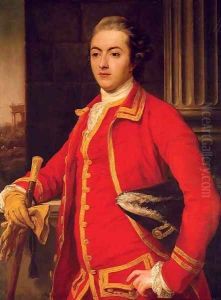Pompeo Batoni Lucca Paintings
Pompeo Girolamo Batoni, born on January 25, 1708, in Lucca, Italy, was a prominent Italian painter whose career flourished in the 18th century. Renowned for his grand style, Batoni is especially celebrated for his portraits and religious compositions. His work exemplifies the transition from the Baroque to the Neoclassical style that dominated European art at the time.
Batoni was the son of a goldsmith, and his initial training was in his father's workshop, where he acquired a fine skill in detailing, which later contributed to the elegance and precision of his paintings. He moved to Rome, the epicenter of the art world, in his early twenties and spent the majority of his career there. Rome provided him with the fertile ground to study the works of the great masters, such as Raphael and Caravaggio, and to immerse himself in the study of classical antiquity.
The artist quickly gained a reputation for his talent and became a favored portraitist among the British nobility and other European aristocrats who were undertaking the Grand Tour—a traditional trip around Europe, with Italy as a key cultural destination. Batoni’s ability to blend the grandeur of the past with the elegance of contemporary fashion made his portraits highly sought after. His famous works include 'Portrait of Sir Wyndham Knatchbull-Wyndham', 'Portrait of John Talbot, later 1st Earl Talbot', and the iconic 'Portrait of Emperor Joseph II with Grand Duke Pietro Leopoldo of Tuscany'.
Batoni was also a respected history painter, and his religious and mythological scenes were praised for their clarity, composition, and emotional resonance. His painting 'The Ecstasy of St. Catherine of Siena' is a fine example of his religious work, while 'Apollo and Two Muses' depicts his skill in classical mythological subjects.
Throughout his life, Batoni was involved with the Accademia di San Luca in Rome, an institution devoted to the promotion of the arts. He held various positions within the academy, including its principal, reflecting his stature in the artistic community.
Pompeo Batoni died in Rome on February 4, 1787. His legacy is marked by the bridging of styles between the late Baroque and the emerging Neoclassicism, and his works continue to be admired for their beauty, technical proficiency, and the insight they provide into the cultural atmosphere of the Grand Tour era in Europe.
